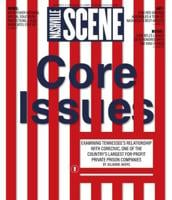
While combing through the 1940 Hume-Fogg High School yearbook, Ben Wilkinson says it’s “like the Bettie Page Show.” Page was her class salutatorian and was voted “Girl Most Likely to Succeed.” Wilkinson, a die-hard Bettie Page fan, led the local campaign for a historical marker in her honor, and pushed for it to be located near the school.
“That was her home,” Wilkinson tells the Scene. “She didn’t have the best home life from what I read. When she was at Hume-Fogg, she was the star.”
Nashville native and “queen of pinups” Page will receive a historical marker outside her alma mater on April 22 — what would have been the late icon’s 100th birthday. Mayor John Cooper has also named April 22 Bettie Page Day.
Jessica Reeves with the Metropolitan Historical Commission was all for the marker.
“We don’t have a lot of popular culture markers,” Reeves says. “For her to be from Nashville — that’s something that the city can really be proud of.
The photogenic brunette bombshell who cut her own bangs and sewed her own lingerie became a household name at 27. She was one of the earliest Playmates of the Month for Playboy, and she was a pioneer of BDSM content.
“She was just a trailblazer in the modeling world,” Wilkinson says. “The images themselves that photographers took of her — they’re some of the most powerful and important modeling images of all time in my opinion.
“Later, she became a symbol of female empowerment,” he continues. “She became a muse for artists. She’s probably one of the most drawn icons of all time. Even actors, designers, musicians — all kinds of creative people owe a lot to Bettie Page. She’s a pop-culture icon.”
It’s Page’s confidence and charisma that stood out to local pinup model Sammi Farra.
“Even back then, she didn’t care what people thought,” Farra says. “She was just going to do what she wanted to do, and it made her happy — that really showed through in her photos. I think that’s what really resonates with me and inspires me.”
One person who tried to quash Page’s career was Tennessee’s U.S. Sen. Estes Kefauver — who has a federal building named for him across from Hume-Fogg at 801 Broadway, as it happens. Page was among Kefauver’s targets in hearings aimed at indecent publications and pornography — things he believed caused “delinquency.”
“That experience traumatized her, and it’s pretty much said that’s the reason she left modeling and disappeared,” Wilkinson says.
Page converted to evangelical Christianity in 1959 and worked for televangelist Billy Graham. She endured severe mental health struggles and all but entirely disappeared from the public eye later in life. Page didn’t get to reap all the benefits of her popularity while she was living, so this marker feels like restitution, Wilkinson says.
“[Estes Kefauver] has a building,” he says. “And right across the street is going to be Bettie Page’s historical marker. You can almost say it’s like a redemption thing. People love Bettie. She persevered. She lasted.”





